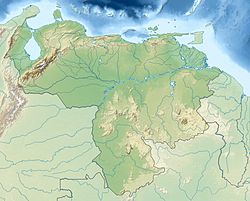Coro Synagogue
| Coro Synagogue | |
|---|---|
(Spanish: Casa de Oración Hebrea) | |
 The former synagogue, now Alberto Henríquez Museum of Art, in 2018 | |
| Religion | |
| Affiliation | Judaism (former) |
| Ecclesiastical or organisational status | |
| Status |
|
| Location | |
| Location | Talavera Street, Santa Ana de Coro, Falcón |
| Country | Venezuela |
Location of the former synagogue, now museum, in Venezuela | |
| Geographic coordinates | 11°24′28″N 69°40′35″W / 11.4079°N 69.6763°W |
| Architecture | |
| Type | House |
| Style | Spanish Colonial |
| Completed |
|
The Coro Synagogue (Spanish: Casa de Oración Hebrea), is a former Jewish synagogue, now museum, located on Talavera Street, in the city of Santa Ana de Coro, Falcón, Venezuela, a city located near the Caribbean Sea coast and the Dutch island of Curaçao. It was one of the oldest synagogues in Latin America.
History
[edit]The former synagogue on Talavera Street was originally built as a house in the first half of the 18th century by the lieutenant governor of Coro Don Francisco Campuzano Polanco as his residence.[1] The house was purchased on July 30, 1847[2] by David Abraham Senior,[3] a Sephardic trader from Curaçao. Senior lived in the city and formed part of the city's growing Jewish community. Prior to Senior's purchase of the Talavera Street house, the community used to gather at the house of David Valencia to pray. It is known that approximately 20 people gathered there[clarification needed] for shabbat and daily prayer services. Senior's son, Isaac, and his descendants continued living in the Talavera Street house and using one of its rooms as a prayer hall, until the 1880s.
Acquisition by the Venezuelan Government
[edit]
On February 6, 1986, the house was bought by the Government of Venezuela, and on August 3, 1997, the government of Falcón State reopened the house under the name of "Casa de Oración Hebrea" (Hebrew Prayer House) as an important cultural contribution[4] that forms part of the Sephardic heritage in northern Venezuela region. The former synagogue on Talavera Street, is located in the city's old quarter. Its floor was covered in the sand of the Médanos de Coro, in the same fashion as the sea sand that covers the floor of Mikvé Israel-Emanuel Synagogue in Willemstad, Curaçao, from where the community arrived from more than two centuries ago.[citation needed]
The former synagogue is part of the Alberto Henríquez Museum of Art, which belongs to Universidad Francisco de Miranda. In 2009, the university contacted the Israelite Association of Venezuela to seek support for the restoration and maintenance of the former synagogue.[5]
See also
[edit]References
[edit]- ^ "Museo Alberto Henríquez, recinto de la prosapia judía en Coro". I am Venezuela (in Spanish). November 13, 2017.
- ^ Aizenberg, Isidoro (1995). La Comunidad Judía de Coro: 1824-1900 (in Spanish). Centro de Estudios Sefardíes de Caracas. ISBN 980-6031-08-3.
- ^ "Boletim ASA nº 101, jul-ago/2006". Associação Scholem Aleichem de Cultura e Recreação (in Portuguese). July–August 2006. Archived from the original on September 23, 2010.
- ^ "Sala de Oración Hebrea". Coroweb.com (in Spanish). Archived from the original on October 27, 2010.
- ^ "Casa de Oración judía en Coro busca aportes solidarios para su restauración". Nuevo Mundo Israelita (in Spanish). Archived from the original on July 14, 2011.
External links
[edit]- "The synagogue of Coro, Venezuela" (Images). VirtualTourist.com.
- "GALERIA DE IMAGENES DE SINAGOGA EN CORO, VENEZUELA". Israelite Association of Venezuela (in Spanish). Archived from the original on July 25, 2011.
- 1774 establishments in Venezuela
- 18th-century synagogues in South America
- Buildings and structures in Coro, Venezuela
- Buildings and structures in Falcón
- Former synagogues in Venezuela
- Houses completed in 1774
- Museums established in 1997
- Sephardi Jewish culture in Venezuela
- Sephardi synagogues
- Spanish Colonial architecture in Venezuela
- Synagogues preserved as museums
- Museums in Venezuela

